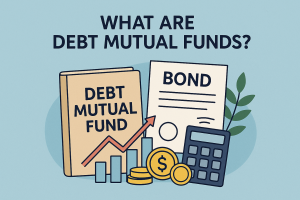
Debt Funds in India: Stable Returns with Lower Risk
Debt Funds in India: Stable Returns with Lower Risk
In the ever-evolving investment landscape, not every investor is seeking high-octane returns from equity markets. Many prioritize capital preservation, stable returns, and low volatility—especially in uncertain times. That’s where debt mutual funds in India step in as a compelling investment option.
Thank you for reading this post, don't forget to subscribe!Over the past decade, Indian investors have increasingly diversified their portfolios with debt instruments. According to AMFI, as of March 2024, debt mutual funds account for over ₹15 lakh crore in Assets Under Management (AUM)—highlighting their growing relevance.
This blog explores what debt funds are, how they function, their benefits and risks, and how they compare with other popular investment options like fixed deposits (FDs) and equity mutual funds.
What Are Debt Mutual Funds?
 Debt mutual funds are investment vehicles that allocate your money into fixed-income instruments such as:
Debt mutual funds are investment vehicles that allocate your money into fixed-income instruments such as:
- Government securities (G-Secs)
- Treasury bills
- Corporate bonds
- Commercial papers (CPs)
- Certificates of deposit (CDs)
These funds generate returns primarily through interest income and potential capital appreciation when bond prices fluctuate with interest rate changes.
Key Advantages of Investing in Debt Funds
- Stability and Lower Risk
Debt funds generally exhibit lower volatility than equity mutual funds, making them suitable for conservative investors, retirees, and those with short-term goals.
- Tax Efficiency
Post-April 2023, debt funds are taxed as per the individual’s income tax slab. Although indexation benefits are no longer available, Systematic Withdrawal Plans (SWPs) and laddering strategies still offer better liquidity and tax planning than FDs.
- Higher Liquidity vs. FDs
Unlike fixed deposits that lock in capital for specific tenures, many debt funds—especially liquid and ultra-short duration funds—allow easy redemption, often with same-day or T+1 settlement.
- Diversification
Debt funds act as a stabilizer in your portfolio. When equity markets turn volatile, the steady returns from debt instruments offer a cushion.
- Customizable to Time Horizons
There are multiple debt fund categories tailored to your investment horizon:
- Liquid Funds: Ideal for 1 day to 3 months
- Ultra Short Duration Funds: For 3 to 6 months
- Short Duration Funds: For 1 to 3 years
- Corporate Bond Funds: For 2 to 5 years
- Gilt Funds: Suitable for long-term, low credit risk exposure
Who Should Consider Debt Mutual Funds?
- First-time investors hesitant to enter equity markets
- Senior citizens looking for safer alternatives to traditional savings
- Salaried professionals building an emergency fund
- Goal-based investors saving for events like tuition fees or a house down payment in the next 1–5 years
Debt funds also work well as part of a balanced or hybrid portfolio to reduce overall risk.
Risk Factors in Debt Fund Investing
While debt funds carry lower risk than equities, they are not risk-free. Understanding these risks is crucial:
- Interest Rate Risk
Bond prices fall when interest rates rise. Long-duration funds are particularly sensitive to this risk.
- Credit Risk
If a corporate bond issuer defaults, the fund’s NAV can drop significantly. Always check the credit quality of underlying holdings.
- Liquidity Risk
In times of financial stress, funds holding low-rated or less-traded papers may face challenges in liquidating assets.
📌 Pro Tip: Choose funds with high-quality holdings (AAA-rated bonds, G-Secs) and avoid chasing high returns from low-rated debt.
Performance Comparison: Debt Funds vs Alternatives
| Investment Option | Avg. 3-Year Return | Liquidity | Taxation (Post-April 2023) |
|
Fixed Deposits (FDs) |
~5.5–6.5% | Locked-in | Taxed as per slab |
|
Liquid Funds |
~4.5–5.5% | T+1 or Same Day | Taxed as per slab |
|
Short Duration Funds |
~6.2–6.8% | T+2 | Taxed as per slab |
|
Corporate Bond Funds |
~6.5–7.5% | T+2 | Taxed as per slab |
|
Gilt Funds (10+ yr) |
~7–8% | T+2 | Taxed as per slab |
Source: Value Research & AMFI data as of Q1 2024. Past performance is not indicative of future returns.
Popular Debt Fund Examples (2024)
- HDFC Corporate Bond Fund – 3Y Return: ~7.2%
- ICICI Prudential Liquid Fund – Consistent short-term returns
- SBI Magnum Medium Duration Fund – Balanced credit quality
- Nippon India Gilt Securities Fund – Long-term government exposure
Conclusion
Debt mutual funds are an essential building block in a well-diversified portfolio. While they may not deliver double-digit returns like equities, they offer capital safety, steady income, and superior liquidity compared to traditional instruments like FDs.
For short- to medium-term investors, or anyone seeking to hedge equity exposure, debt funds are an ideal investment route. Just remember: not all debt funds are created equal—understand the category, check the fund’s portfolio, and align it with your goal and risk appetite.
Begin with Debt Funds Today
At Goodwill Wealth Management, we help you identify the right debt fund based on your timeline, tax situation, and risk profile.
Talk to an advisor and explore how debt mutual funds can add stability and predictability to your investment journey.

